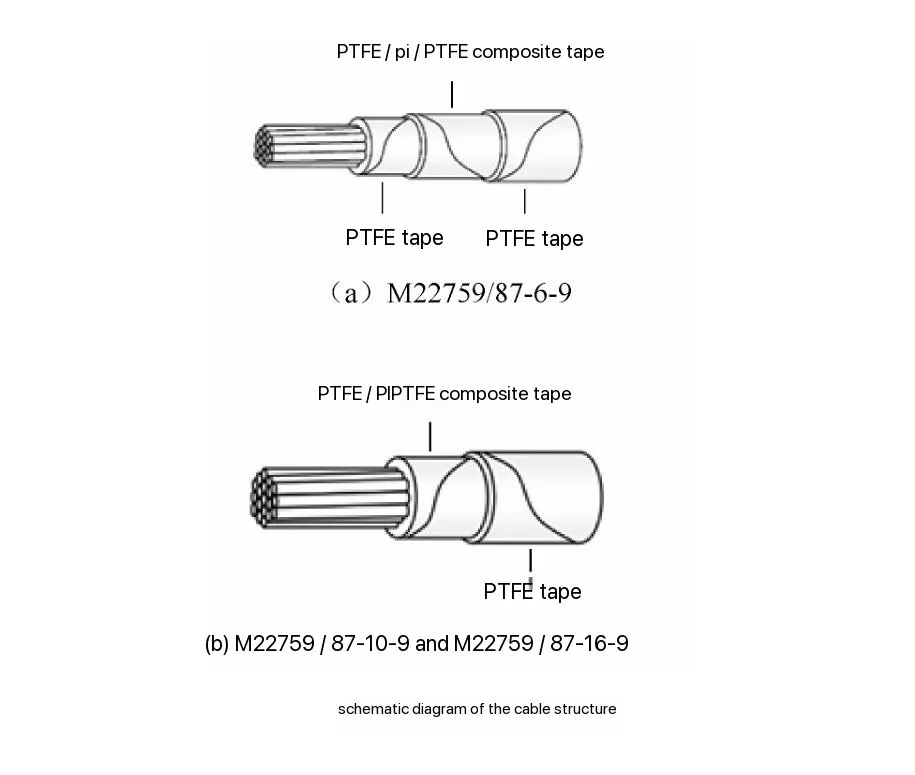Simulation and Analysis of Current Carrying Capacity for PTFE/PI Aerospace Wires
Introduction
Aerospace electrical wiring systems (EWIS) require precise current-carrying capacity calculations to ensure safe and efficient aircraft operation. With the growing demand for reliable insulation materials, PTFE/PI (Polytetrafluoroethylene/Polyimide) composite insulated wires have gained prominence due to their high-temperature resistance and electrical stability. This article reviews a study on the current-carrying capacity of PTFE/PI insulated aerospace wires, utilizing COMSOL multiphysics simulations and experimental validation.
Overview of PTFE/PI Aerospace Wires
PTFE/PI insulated wires are widely used in aircraft electrical systems due to their high thermal stability, excellent dielectric properties, and lightweight flexibility, making them ideal for complex wiring configurations.
The study focused on three different wire sizes, following the SAE AS50881H:2023 standard:
- M22759/87-6-9 (largest diameter)
- M22759/87-10-9
- M22759/87-16-9 (smallest diameter)
| Wire Type | Conductor Diameter (mm) | Insulation Thickness (mm) | Overall Diameter (mm) | Standard |
|---|---|---|---|---|
| M22759/87-6-9 | 5.10 | 0.23 | 5.56 | SAE AS50881H:2023 |
| M22759/87-10-9 | 2.74 | 0.20 | 3.13 | SAE AS50881H:2023 |
| M22759/87-16-9 | 1.31 | 0.20 | 1.72 | SAE AS50881H:2023 |
Simulation Methodology
To determine the current-carrying capacity, the study employed a multi-physics coupled model using COMSOL software. The methodology involved:
Experimental Setup
- Wires were tested in a controlled environment at a temperature of 25±2°C.
- Conductors were heated by applying increasing electrical current until they reached a steady-state temperature of 260°C.
- Measurements were recorded and compared to SAE AS50881H:2023 standard values.
Simulation Parameters
- Electromagnetic-thermal coupling: Maxwell’s equations were used to calculate heat generation from current flow.
- Heat transfer modeling: The simulation accounted for convective heat dissipation into the surrounding air.
- Boundary conditions: The initial temperature was set between 23.5 and 25.8°C, with natural convection cooling.
Key Findings from the Study
1. Experimental Current Carrying Capacity
The measured current required to reach 260°C was recorded for each wire type:
| Wire Type | Tested Current (A) | Measured Temperature (°C) |
|---|---|---|
| M22759/87-6-9 | 210.4 | 260 |
| M22759/87-10-9 | 108.1 | 260 |
| M22759/87-16-9 | 46.7 | 259 |
The actual tested values showed slight variations due to environmental factors such as air convection and measurement device placement.
2. Simulation vs. Experimental Results
The COMSOL model predicted conductor temperatures under identical electrical loads:
| Wire Type | Simulated Temperature (°C) | Experimental Temperature (°C) | SAE Standard (°C) |
|---|---|---|---|
| M22759/87-6-9 | 247.2 | 260 | 246 |
| M22759/87-10-9 | 274.6 | 260 | 271 |
| M22759/87-16-9 | 304.0 | 259 | 305 |
The simulation closely matched the SAE standard, validating its accuracy for predicting wire performance in real-world applications.
3. Influence of Wire Size on Heat Dissipation
Larger diameter wires dissipate heat more efficiently, leading to lower temperature rises. Smaller wires retain more heat, resulting in higher temperatures for the same current level.
Discussion and Recommendations
Advantages of Using COMSOL Simulations
- Reduces the need for extensive physical testing, saving time and costs.
- Provides accurate temperature predictions for different wire configurations.
- Helps optimize wire selection in aerospace design to prevent overheating risks.
Potential Limitations
- Minor deviations between simulated and tested temperatures indicate that environmental factors such as humidity and airflow can influence real-world results.
- Additional refinements in thermal modeling could improve simulation accuracy for smaller-diameter wires.
Practical Applications
- Aircraft electrical systems benefit from improved safety and performance optimization.
- High-temperature environments such as satellite and space exploration wiring can use the findings for better material selection.
- Industrial applications requiring lightweight, heat-resistant wiring can adopt similar modeling techniques.
Conclusion
This study demonstrated that PTFE/PI composite insulated aerospace wires exhibit reliable thermal and electrical performance, with current-carrying capacities aligning with SAE AS50881H:2023 standards. COMSOL-based simulations provided accurate predictions, reducing the need for expensive experimental testing.
By leveraging advanced simulation tools, engineers can optimize wire selection to enhance the safety and efficiency of aerospace electrical systems.
Future work should focus on additional validation across different ambient temperatures and altitudes to refine the accuracy of predictive modeling.
Keywords
Aerospace wires, PTFE insulation, current carrying capacity, COMSOL simulation, thermal analysis.
References
- Han, Y., Zhu, M., Zhang, Z., Liu, J. (2024). Current Carrying Capacity Simulation of PTFE/PI Aerospace Wires. Wire & Cable, No. 5, 2024.
- SAE AS50881H:2023 - Wiring Aerospace Vehicles.
- HB 5795—2023 - Aerospace Wire Current Carrying Capacity Standard.
- COMSOL Multiphysics Simulation Guide.
This article provides a clear, accessible summary of complex technical research, ensuring better understanding for industry professionals and engineers working with aerospace electrical systems.
Source: JianYunCable

Comments
Post a Comment